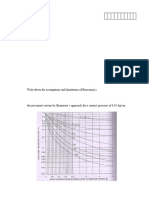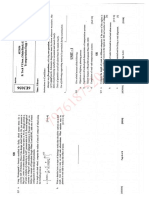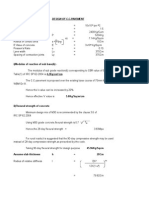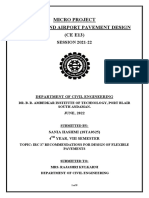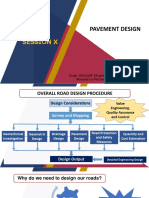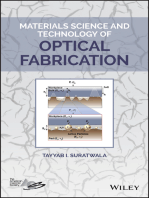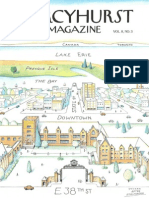0 ratings0% found this document useful (0 votes)
221 viewsTutorial II
The document is the notes from a tutorial on pavement design for a civil engineering course. It covers several topics:
1) It introduces the concepts of equal stress and equal deflection criteria for determining equivalent single wheel load (ESWL) and asks students to explain ESWL and factors affecting it.
2) It provides example problems for students to calculate ESWL for different wheel and pavement configurations using graphical methods.
3) It classifies flexible pavement design methods and asks students to explain the Mcleod and CBR methods. Example problems are given applying these methods.
4) It also covers rigid pavement design using Westergaard's stress equations, asking students to calculate stresses at different
Uploaded by
NmCopyright
© © All Rights Reserved
Available Formats
Download as PDF, TXT or read online on Scribd
0 ratings0% found this document useful (0 votes)
221 viewsTutorial II
The document is the notes from a tutorial on pavement design for a civil engineering course. It covers several topics:
1) It introduces the concepts of equal stress and equal deflection criteria for determining equivalent single wheel load (ESWL) and asks students to explain ESWL and factors affecting it.
2) It provides example problems for students to calculate ESWL for different wheel and pavement configurations using graphical methods.
3) It classifies flexible pavement design methods and asks students to explain the Mcleod and CBR methods. Example problems are given applying these methods.
4) It also covers rigid pavement design using Westergaard's stress equations, asking students to calculate stresses at different
Uploaded by
NmCopyright
© © All Rights Reserved
Available Formats
Download as PDF, TXT or read online on Scribd
You are on page 1/ 2
S.J.C.
Institute of Technology, Chickballapur
Department of Civil Engineering
Tutorial – II
Subject : Pavement Design Code : 10CV833
Semester : VIII ‘A & B’ Date : 12-04-2018
Staff : Sathish Y A
Unit – III
1 Explain how ESWL is found out by
i) Equal stress criteria
ii) Equal deflection criteria
2 What is ESWL? Mention the various factors affecting the ESWL, state the importance of ESWL.
3 Explain the concept of ESWL. How is it determined graphically for tandem dual wheel assembly?
4 Calculate the ESWL of a dual wheel assembly carrying 2044 kg each for pavement thickness of 150 mm,
200 mm and 250 mm. Centre to centre tyre spacing is 270 mm and distance between walls of tyres is 110
mm.
5 Determine ESWL for a dual tandem wheel load assembly, where each wheel is 60 kN with contact
pressure of 0.6 MPa. Center to center distance between dual tandem axle is 1600 mm and center to center
spacing of dual wheel is 800 mm. Determine ESWL at 350 mm and 700 mm depth.
Unit – IV
6 Explain with examples, how are the flexible pavement design methods classified.
7 Explain the Mcleod method of highway pavement design.
8 Write a equation recommended IRC:37-2001 for the computation of design traffic. Explain each term.
How are the values obtained?
9 Explain briefly CBR method by cumulative standard axle load for the design of flexible highway
pavements.
10 Design a highway pavement for a wheel load of 4100 kg with a tyre pressure of 5 kg/cm2 by Mcleod
method. The plate bearing test carried out on subgrade soil using 30 cm diameter plate yielded pressure
of 2.5 kg/cm2 after 10 repetitions of load at 0.5 cm deflection.
11 Design the flexible pavement by Triaxial method using the following data:
E – value of subgrade soil = 100 kg/cm2 E – value of base course = 400 kg/cm2
2
E – value of 8 cm thick bituminous surface = 1000 kg/cm Design wheel load = 6000 kg
Radius of contact area = 15 cm Traffic coefficient = 1.5
Rainfall coefficient = 0.6 Design deflection = 0.25 cm
12 Design the pavement by Triaxial method using the following data:
Wheel load = 51 kN Radius of contact area = 150 mm
Traffic coefficient = 1.5 Rainfall coefficient = 0.9
Design deflection = 2.5 mm E – value of subgrade soil = 10 N/mm2
2
E – value of base course material = 40 N/mm
E – value of 75 mm thick bituminous concrete surface = 100 N/mm2
13 Design the pavement thickness by California ‘R’ value method using the following data:
i) Traffic index = 10.5
ii) C – of base course = 15,
iii) C – of 7.5 cm thick bituminous surface course = 65.
The results on subgrade soil as under
Pressure (kg/cm2)
Moisture content (%) R – value
Expansion Exudation
17 65 0.130 48.5
20 42 0.095 34.0
23 15 0.045 22.0
14 Design a flexible pavement by CBR method based on IRC:37-2001 recommendations using the
following data:
i) Pavement : 2 lane
ii) Traffic volume : 700 CV/day
iii) Road construction period : 3 years
iv) Rate of growth of traffic : 8%
v) Lane distribution factor : 0.75
vi) Design size : 15 years
vii) Vehicle damage factor : 3.5
viii) Subgrade CBR :6%
Unit – V
15 Explain the following:
a) Modulus of subgrade reaction
b) Relative stiffness of slab to subgrade
c) Equivalent radius of resisting section
d) Critical load positions
16 Explain the factors affecting design of rigid pavements or CC pavements.
17 Calculate the stresses at interior, edge and corner regions of a C.C pavement using Westergaard’s stress
equations use the following data: wheel load = 5100 kg (51kN), E = 3 x 10 5 kg/cm2 (0.3x108 kN/m2),
µ = 0.15, pavement thickness = 18 cm, modulus of subgrade reaction = 6 kg/cm 3 (6.0x104 kN/m3), radius
of concrete area = 15 cm.
18 Calculate the stresses at interior, edge and corner of CC pavement by Westergaard’s analysis.
Radius of concrete area = 150 mm E – value of concrete = 0.32 x 105 N/mm2
Wheel load = 60 kN µ = 0.15
Thickness of pavement = 28cm = 280mm Modulus of subgrade reaction, K = 0.08 N/mm3
You might also like
- Elective-II: Pavement Analysis & Design: B.E. (Civil Engineering) Eighth Semester (C.B.S.)No ratings yetElective-II: Pavement Analysis & Design: B.E. (Civil Engineering) Eighth Semester (C.B.S.)4 pages
- Elective - II: Pavement Analysis & Design: B.E. (Civil Engineering) Eighth Semester (C.B.S.)No ratings yetElective - II: Pavement Analysis & Design: B.E. (Civil Engineering) Eighth Semester (C.B.S.)27 pages
- Elective-II: Pavement Analysis & Design: B.E. (Civil Engineering) Eighth Semester (C.B.S.)No ratings yetElective-II: Pavement Analysis & Design: B.E. (Civil Engineering) Eighth Semester (C.B.S.)6 pages
- BRIDGE ENGINEERING S7 CE B.Tech Dec.2018 - Ktu QbankNo ratings yetBRIDGE ENGINEERING S7 CE B.Tech Dec.2018 - Ktu Qbank2 pages
- Bridge Engineering s7 Ce b.tech Dec.2018 - Ktu QbankNo ratings yetBridge Engineering s7 Ce b.tech Dec.2018 - Ktu Qbank2 pages
- Elective - II: Pavement Analysis & Design: B.E.Eighth Semester (Civil Engineering) (C.B.S.)No ratings yetElective - II: Pavement Analysis & Design: B.E.Eighth Semester (Civil Engineering) (C.B.S.)12 pages
- CEE 575 PART 1 - ROAD PAVEMENT CHARACTERISTICSNo ratings yetCEE 575 PART 1 - ROAD PAVEMENT CHARACTERISTICS23 pages
- Assignment - 1 Pavement Analysis and Design: (Units Covered: 1, 2, 3 & 4)No ratings yetAssignment - 1 Pavement Analysis and Design: (Units Covered: 1, 2, 3 & 4)2 pages
- D F1076 Pages: 3: Answer Any Two Full Questions, Each Carries 15 MarksNo ratings yetD F1076 Pages: 3: Answer Any Two Full Questions, Each Carries 15 Marks3 pages
- Transportation Engineering 1 Question Bank - Mumbai University0% (1)Transportation Engineering 1 Question Bank - Mumbai University10 pages
- Ce2255 Highway Engineering Anna University Question BankNo ratings yetCe2255 Highway Engineering Anna University Question Bank8 pages
- Part-E Design Examples of Bridges: Road Structures Manual For Single Lane BridgesNo ratings yetPart-E Design Examples of Bridges: Road Structures Manual For Single Lane Bridges55 pages
- Design of Flexible Pavement - Irc MethodNo ratings yetDesign of Flexible Pavement - Irc Method9 pages
- CCIVL - 7 - Y3 CIVL7009 Geotechnical EngineeringNo ratings yetCCIVL - 7 - Y3 CIVL7009 Geotechnical Engineering4 pages
- Materials Science and Technology of Optical FabricationFrom EverandMaterials Science and Technology of Optical FabricationNo ratings yet
- Discrete-continuum Coupling Method to Simulate Highly Dynamic Multi-scale Problems: Simulation of Laser-induced Damage in Silica Glass, Volume 2From EverandDiscrete-continuum Coupling Method to Simulate Highly Dynamic Multi-scale Problems: Simulation of Laser-induced Damage in Silica Glass, Volume 2No ratings yet
- Insightsias 75 Days Revision Plan For Upsc Civil Services Preliminary Exam - 2019No ratings yetInsightsias 75 Days Revision Plan For Upsc Civil Services Preliminary Exam - 201911 pages
- Eligibility For Government Seats: Documents To Be ProducedNo ratings yetEligibility For Government Seats: Documents To Be Produced3 pages
- Supports The Recruitment Drive For: Visvesvaraya Technological UniversityNo ratings yetSupports The Recruitment Drive For: Visvesvaraya Technological University3 pages
- Floors and Roofs Heavy Duty Floors Tiles Waterproofing Mumbai IndiaNo ratings yetFloors and Roofs Heavy Duty Floors Tiles Waterproofing Mumbai India5 pages
- Limitstatelessons - Blogspot.in-Reinforced Concrete DesignNo ratings yetLimitstatelessons - Blogspot.in-Reinforced Concrete Design14 pages
- UNIT-3: SP - GR Water Absorption Free (Surface-Moisture)No ratings yetUNIT-3: SP - GR Water Absorption Free (Surface-Moisture)2 pages
- Civil-Vii-pavement Materials and Construction (10cv763) - Question Paper100% (1)Civil-Vii-pavement Materials and Construction (10cv763) - Question Paper3 pages
- PID Control Experiment: Mechanical Engineering LabNo ratings yetPID Control Experiment: Mechanical Engineering Lab4 pages
- Constitutional Design Question and AnswersNo ratings yetConstitutional Design Question and Answers2 pages
- Students' Reasoning in Fluid Dynamics: Bernoulli'S Principle vs. The Continuity EquationNo ratings yetStudents' Reasoning in Fluid Dynamics: Bernoulli'S Principle vs. The Continuity Equation8 pages
- Chapter XI-Adjective and Adjective Clause in ...No ratings yetChapter XI-Adjective and Adjective Clause in ...13 pages
- Pengaruh Marketing Mix Terhadap Keputusan Pembelian Pada Orange MartNo ratings yetPengaruh Marketing Mix Terhadap Keputusan Pembelian Pada Orange Mart100 pages
- Satit Bilingual School of Rangsit UniversityNo ratings yetSatit Bilingual School of Rangsit University1 page
- Fracture Strength of Endodontically Treated Maxillary Premolars Supported by A Horizontal Glass Fiber Post: An in Vitro StudyNo ratings yetFracture Strength of Endodontically Treated Maxillary Premolars Supported by A Horizontal Glass Fiber Post: An in Vitro Study6 pages
- Extra Exercises: 1 Choose The Right Word. Now Match The Answers With The Questions in Exercise 3No ratings yetExtra Exercises: 1 Choose The Right Word. Now Match The Answers With The Questions in Exercise 33 pages
- The Time Machine As A Dystopian FictionNo ratings yetThe Time Machine As A Dystopian Fiction20 pages















